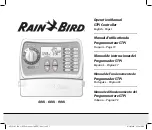
Draining Water
Inspect or drain the sump of water on a regular basis. Utilize the water sight glasses to determine level of water accumulation.
Above Ground Fuel Tank Applications or Transfer Pump* Pressure Side Applications:
1. Open the drain to evacuate contaminants with a suitable collection container in place. Head pressure will push the
contaminants out while priming the filter. Transfer pump applications, see asterisk (*) note below.
Below Ground Fuel Tank Applications or Transfer Pump* Applications:
1. Close the inlet valve and open the drain valve. Open the vent to release the vacuum within the unit. Close the drain.
2. Prime the unit by removing the lid and filling the unit with clean fuel. Transfer pump applications, see asterisk (*) note below.
3. Replace the Lid and snugly tighten the hex bolts on the lid.
*Note: If using a transfer pump, open the drain, start the pump and then close the drain after all water is evacuated.
Element Replacement
Replace the element annually as a minimum or when the differential pressure gauge reads 15 PSI. The actual measurement
will vary with different fuel systems. When flow rate drops, it may be time for element change.
All Tank Applications:
1. Close all valves to the unit to be serviced or by--pass, as applicable.
2. Remove the lid and remove the elements by holding the element or bail handle and pulling slowly with an upward twisting
motion.
3. Insert the elements slowly and twist the element downward until it seats.
4. Replace the lid gasket after lubricating with clean fluid or oil.
5. Refer to ’Priming the units’, otherwise, fill the unit with clean fuel, then replace the lid. Snugly tighten the lid hex bolts to
80 ft.lbs.
Note: On above ground tank or transfer pump applications, you may use fuel pressure to prime the unit.
Important: Remember to open the air vent to evacuate all air.
BVFS- 1
50 GPM
BVFS- 2
100 GPM
BVFS- 3
150 GPM
39”
51”
65”
13.75 ”
all models






















